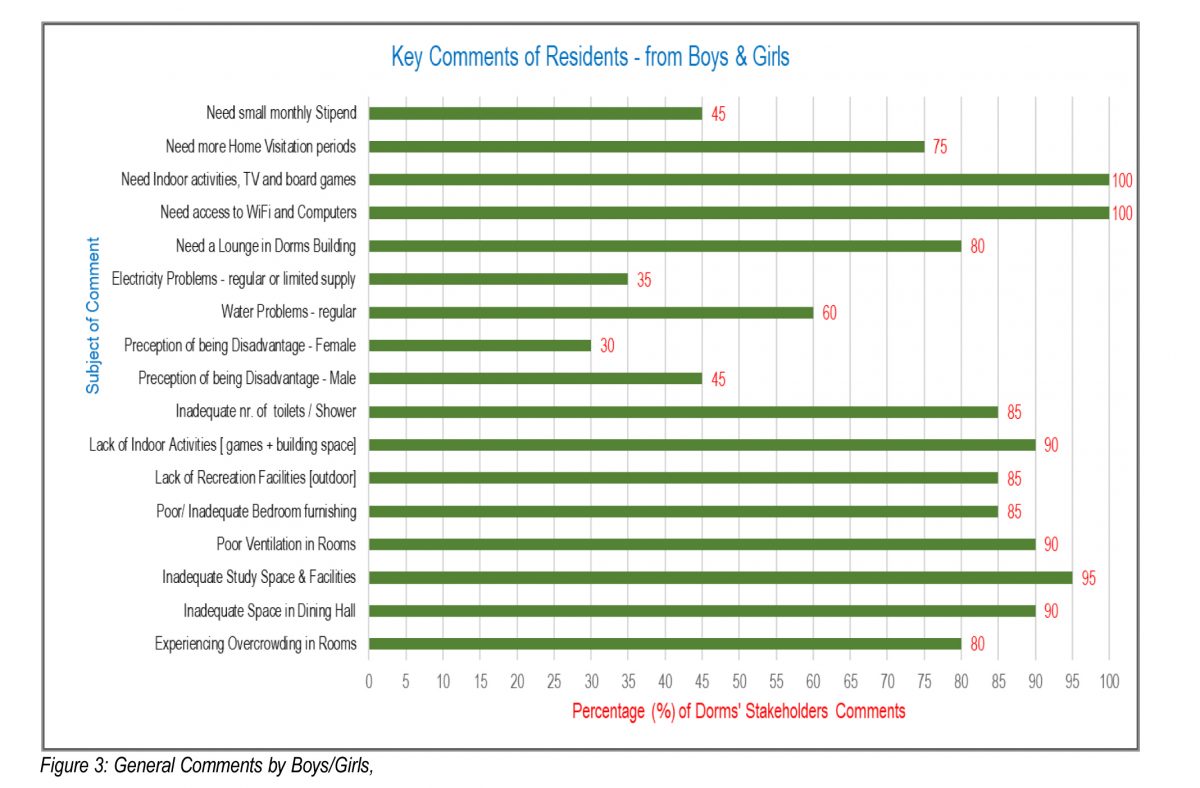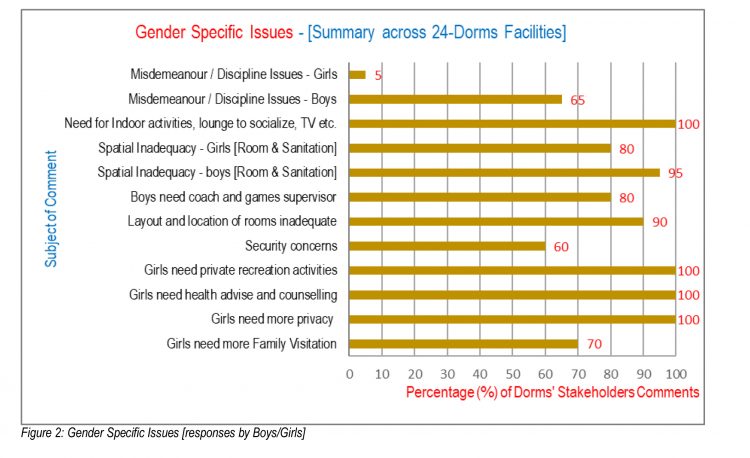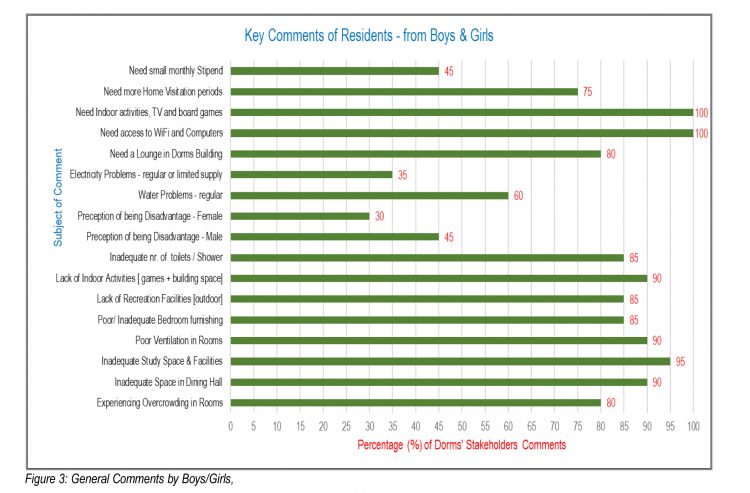A United Nations Children’s Fund (UNICEF) assessment of all 24 school dormitories across the country last year highlighted a plethora of deficiencies to the Ministry of Education and another followed with myriad recommendations but it is unclear if any changes were made.
“All the school dormitory facilities have systemic and similar issues related to management system inadequacies, lack of resources and inadequate functional spaces, major shortage of staff and behavioural issues with students,” read the report titled ‘Assessment Report – Field Study of Dormitory Plants…Development of Gender Sensitive Standards for Dormitory Schools in Guyana’, seen by the Stabroek News.
The report of recommendations ‘Gender Sensitive Standards for Dormitory Schools in Guyana’ had a section dedicated to fire protection systems, including that smoke detectors be installed and drills conducted regularly.
“Fire drill is essential for all school dormitory facilities and should be held three times per school term. The drill should include all students and staff and follow the Ministry of Education fire drill procedures. Training in the use of fire extinguishers, fire sand buckets and evacuation procedures should be done for students and all staff at least one per school academic year. Procedures for evacuation of buildings with indication of assembly areas should be documented in a printed form and affixed near all building exits. Printed information should be posted in visible areas with fire safety rules, evacuation procedures and identification of “assembly safe zone/area” should be done to all buildings, that report highlighted.
Stabroek News reached out to Minister of Education Priya Manickchand yesterday for comments, but up to press time she had not responded.
Coming to the fore after the national tragedy at Mahdia where a fire at the dormitory claimed the lives of 20 children, the report highlighted not only the poor conditions mostly hinterland children endure at the boarding schools but that Ministry of Education officials were told of the situations.
Recommendations were given for both fire prevention and safety and response with the report giving guidelines of being equipped and utilising standard building codes.
“All dormitory buildings shall have a minimum of two access doorways from any and all spaces. If there is only one fire exit, the travel distance from any space within the building to the fire exit door shall not be more than 59 ft [18m]. If there are two or three fire and emergency exits, the travel distance from any space within the building to the fire exit doors, shall not be more than 150 ft [45m]
“Swing of Doors: All exit [egress] doors shall swing outwards, toward the egress/escape path, with a full 90-degree outward swing.
“Type of Doors: Emergency exit doors shall be strong door type, preferably metal fire doors with a view panel and push panic bar. This door should be affixed with 4nr. butt hinges,” one recommendation stated.
It was noted that fire exit signs are to facilitate quick exit from buildings by identifying the escape route(s) and enabling students to find the exit nearest to them. Therefore, the report recommended that signs be located where visible, suggesting a distance of 55ft [17m] and preferably above doors. They should read “FIRE EXIT” in text the height of 7 inches, with a graphical image showing a man running through a rectangular doorway with a directional arrow pointing the way, the report recommended. “Fire exit doors themselves should bear an appropriate sign, eg ‘Fire Exit – Keep Clear’, with an illuminated fire exit sign above. The panic exit hardware must carry a ‘Push Bar to Open’ sign. For emergency exits in commercial premises, each push pad must carry a ‘Push’ sign where the pad is to be depressed,” it added.
After speaking with management of all of the dorms in this country, the report stated that the result was that 100% of them believed that safety and health measures at their facilities were poor, some 85% said that overcrowding was a key deficiency and also related that students needed more recreational facilities, while 80% pointed out that there were water, power and sanitation deficiencies at their institutions.
When the students residing in the dorms were spoken to, staggering numbers highlighted overcrowding, poor ventilation in the rooms, inadequate toilets and showers and poor and inadequate bedroom furnishings. The children also made a plea for internet in their dorms, and that they be given designated spaces for a lounge as in most cases there is none in the dorms building.
Where their dormitory caregivers had highlighted a lack of recreational facilities, the 85% number was the same for students except that when it came to the provision of indoor activities 100% highlighted that there was a deficiency and they needed more options such as board games or a basic television to watch.
All of the students also stated that they needed access to computers and the internet/Wi-Fi.
The tables below highlight the respective responses of staff and students, as illustrated in the report.
The UNICEF report explained that adequate accommodation with support utilities are a basic need, like food and clothing, and fundamental for guaranteeing human dignity. Therefore this is essential in an education environment for students to grow, develop and experience stimulating, satisfying and comfortable surroundings as a home away from home.
Since dormitories greatly influence the physical and mental health of students and provide them with a place to socialise, study and rest after school hours, thus impacting, positively or negatively, on their quality of life as well as their further interest in education pursuits, the study was needed to assess the conditions under which Guyanese children are kept.
The report said it was recognised that dormitories in Guyana vary significantly with respect to physical condition, available resources, spatial disposition and management systems. “The Ministry of Education recognises that with extreme climate events and migrant flows, significant steps and investment must be taken to ensure safe learning environments; which include schools in the hinterland regions, some of which include dormitories for non-resident students,” the report outlined.
The report informed that independent consultancy firm, Deen + Partners architects was engaged to undertake a comprehensive review of the 24 active school dormitories across nine geographical regions of Guyana. The assignment involved the development of a comprehensive gender sensitive standard for dormitory schools in Guyana – “ensuring comfortable, safe, resilient learning and living spaces created through a focus on the use of green technologies, sustainable resources and locally available materials and skills,” the report stated.
The consultancy team, according to the report, used and referenced relevant documents pertaining to education and accommodation standards, gender sensitive guidelines, hygiene guidelines, safe and model schools’ guidelines, hazards risk management frameworks and information acquired from consultations with stakeholders.
The objective was to identify general deficiencies, concerns, constraints, needs and expectations. The review also sought to establish the “perception of the functional space’s adequacy with respect to quantity and quality” as well as identify “… issues that are gender specific in the dormitory life setting,” the report said. Further, the assignment allowed for the “identification of spatial inequalities and patterns… issues that are gender specific in the dormitory life setting, perception and use of space with need for personal space, privacy and social interaction, adequacy of facilities and utilities…” and the discovery of “stakeholders views on development standards for physical facilities, administration and operation of the dormitory…”
Stakeholders included personnel from the Ministry of Education in Georgetown – Administration and Planning, Regional Education Office and Regional Democratic Council, the District Education Official, Headteacher and school administration, Village Captain (Toshao) where applicable, dormitory staff – cooks, maids, house parents, supervisor, handyman, and occupants – boys and girls, according to the report.
In all instances, face-to-face meetings were convened with the dormitory staff on site and regional officials were interviewed at their offices, the report explained.







